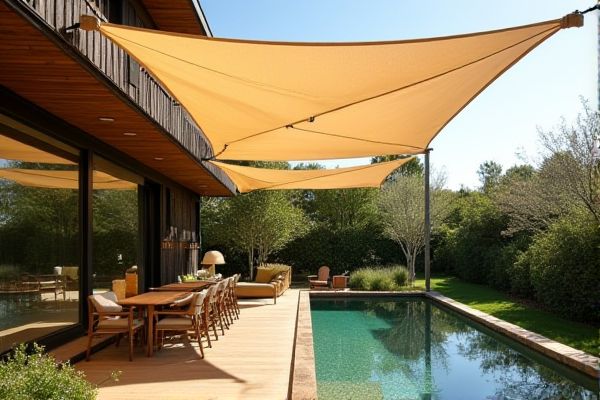
Sun sail shades offer a modern, minimalist aesthetic combined with durable, UV-resistant fabrics that provide flexible shading options, while fabric canopies typically deliver a more traditional look with thicker, often water-resistant materials suited for larger, fixed areas. Explore this article to discover which shading solution best enhances your outdoor space.
Table of Comparison
| Feature | Sun Sail Shade | Fabric Canopy |
|---|---|---|
| Material | Durable UV-resistant fabric | Heavy-duty canvas or polyester fabric |
| Installation | Easy to install with anchor points or poles | Requires frame or structure for setup |
| Sun Protection | High UV protection, blocks up to 98% | Effective UV protection but less ventilation |
| Design | Modern triangular or square shapes | Traditional tent or pavilion styles |
| Portability | Lightweight and easy to fold | Heavier due to frame and fabric |
| Wind Resistance | Moderate wind resistance, needs proper tension | Better stability with rigid frame |
| Cost | Generally more affordable | Usually more expensive due to materials and structure |
| Maintenance | Low maintenance, easy to clean | Requires periodic frame and fabric care |
Introduction to Sun Sail Shades and Fabric Canopies
Sun sail shades offer a modern, sleek solution for outdoor shading, utilizing tensioned fabric anchored to posts or walls to create aerodynamic, triangular or rectangular canopies. Fabric canopies typically consist of heavier materials supported by frames, providing structured, versatile protection against sun and rain in various outdoor settings. Both options enhance outdoor spaces by reducing UV exposure and improving comfort, with sun sail shades excelling in contemporary aesthetics and fabric canopies offering more traditional, durable coverage.
Material Comparison: Durability and Weather Resistance
Sun sail shades are typically made from high-density polyethylene (HDPE) fabric, offering excellent UV protection and superior breathability, which helps reduce heat buildup; this material is highly durable against sun exposure and resists fading. Fabric canopies often use polyester or acrylic materials that provide robust water resistance and tend to withstand heavy rain and wind better than sun sail shades, but they may retain heat more. Your choice depends on whether you prioritize breathable, UV-resistant shading or more comprehensive weatherproof coverage for long-term durability.
Installation Process: Ease and Flexibility
Sun sail shades offer a streamlined installation process with flexible anchor points, adapting easily to various outdoor spaces without requiring extensive hardware or support structures. Fabric canopies typically involve a more complex installation, often needing frameworks or poles, which can limit placement options and require professional assembly for stability. The lightweight nature of sun sails allows quick adjustments and seasonal removal, enhancing convenience compared to the more permanent setup of fabric canopies.
Design Options and Aesthetic Appeal
Sun sail shades offer sleek, modern design options with clean lines and a variety of geometric shapes that enhance contemporary outdoor spaces. Fabric canopies provide traditional aesthetic appeal with more structured forms and often incorporate decorative elements like scalloped edges or patterns. Your choice depends on whether you prefer minimalist elegance or classic, detailed style for your outdoor area.
UV Protection and Shade Coverage
Sun sail shades offer superior UV protection by utilizing high-density, UV-stabilized materials that block up to 95% of harmful rays, ensuring your outdoor space remains cool and safe. Fabric canopies, while providing ample shade coverage, often rely on thinner fabrics that may allow more UV penetration, reducing their protective effectiveness over time. Choosing a sun sail shade enhances your comfort and safety by delivering broader, more reliable sun protection for extended outdoor use.
Cost Analysis: Initial Investment and Maintenance
Sun sail shades generally require a lower initial investment compared to fabric canopies, as they use less material and simpler installation methods. Maintenance costs for sun sail shades are minimal, typically involving periodic cleaning and tension adjustments to prevent sagging. Fabric canopies often have higher upfront expenses due to heavier materials and more complex structures, with maintenance involving regular inspections for tears, water pooling, and potential fabric replacement.
Versatility for Outdoor Spaces
Sun sail shades provide exceptional versatility for outdoor spaces by offering customizable shapes and sizes that easily adapt to various landscaping designs and seating arrangements. Fabric canopies deliver reliable coverage with more rigid structures, suitable for permanent installations but less flexible in configuration options. Choosing between sun sail shades and fabric canopies depends on the desired balance between adaptable coverage and stable, fixed protection for patios, decks, or gardens.
Portability and Storage Considerations
Sun sail shades are lightweight and easy to fold, making them highly portable and ideal for quick setup and storage in compact spaces. Fabric canopies often require more space and time to assemble and may include heavier frames, which can limit portability and complicate storage. Choosing a sun sail shade enhances your convenience for frequent relocation and minimal storage needs.
Longevity and Replacement Factors
Sun sail shades typically offer greater longevity due to their UV-resistant, high-density polyethylene fabric, which resists fading and tearing over several years. Fabric canopies may require more frequent replacement as they often use less durable materials prone to weather damage and mildew. Your choice depends on balancing long-term durability with maintenance needs and aesthetic preferences.
Which Option is Best for Your Needs?
Sun sail shades offer a modern, stylish solution with UV protection and easy installation, ideal for creating flexible outdoor coverage in various shapes and sizes. Fabric canopies provide more robust, permanent shelter, often made from thicker materials that resist weather elements and provide consistent shade over larger areas. Choosing between the two depends on your priorities: sun sail shades suit temporary or customizable shading needs, while fabric canopies are better for durable, long-term outdoor protection.
 homyna.com
homyna.com